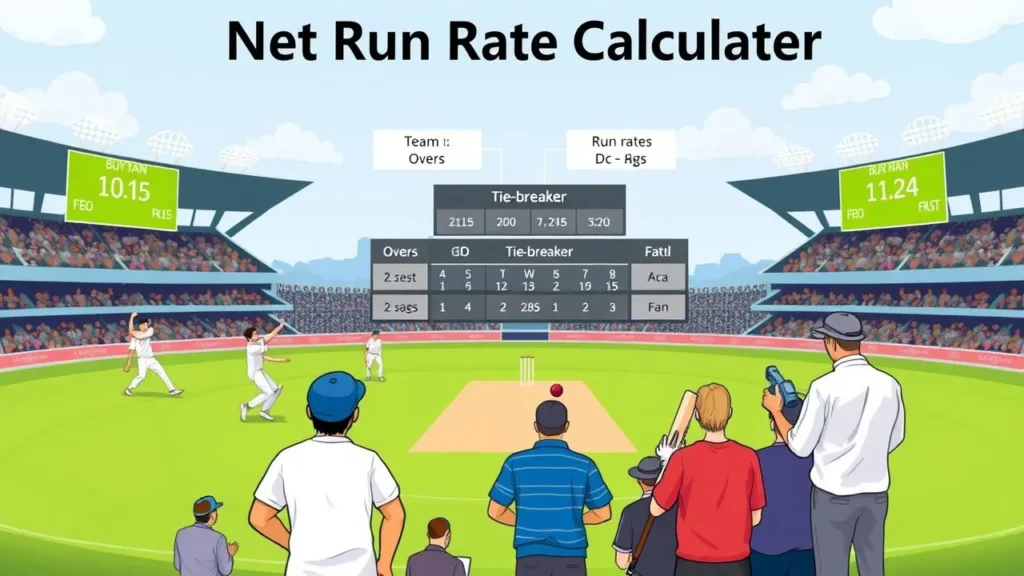Net Run Rate Calculator
Calculate cricket team's net run rate quickly and accurately
What is Net Run Rate?
Net Run Rate (NRR) is a statistical method used in cricket to rank teams in limited-overs tournaments. It represents the average runs per over that a team scores, minus the average runs per over that is scored against them.
Why is NRR Important?
In tournament formats where teams may finish with equal points, NRR serves as a tiebreaker to determine which team advances or ranks higher. A higher NRR indicates better overall performance.
How is NRR Calculated?
The formula for Net Run Rate is:
NRR = (Total Runs Scored / Total Overs Faced) - (Total Runs Conceded / Total Overs Bowled)
Key Points to Remember
- All runs scored and conceded in the tournament are included in the calculation
- Overs are counted in decimal format (e.g., 45.3 overs = 45 overs and 3 balls)
- A positive NRR means the team scores faster than its opponents on average
- A negative NRR means the team scores slower than its opponents on average
- NRR can change significantly based on a single very good or very poor performance
NRR Calculation Examples
Scenario: A team scores 500 runs in 100 overs and concedes 450 runs in 100 overs.
Calculation:
Run Rate For = 500 / 100 = 5.00
Run Rate Against = 450 / 100 = 4.50
NRR = 5.00 - 4.50 = +0.50
Scenario: A team scores 250 runs in 48.3 overs (48.5 overs in decimal) and concedes 240 runs in 50 overs.
Calculation:
Run Rate For = 250 / 48.5 ≈ 5.1546
Run Rate Against = 240 / 50 = 4.80
NRR ≈ 5.1546 - 4.80 ≈ +0.3546 (rounded to +0.355)
Scenario: A team scores 180 runs in 50 overs and concedes 200 runs in 45 overs.
Calculation:
Run Rate For = 180 / 50 = 3.60
Run Rate Against = 200 / 45 ≈ 4.4444
NRR = 3.60 - 4.4444 ≈ -0.8444 (rounded to -0.844)
Scenario: In a 5-match series, a team has the following performances:
- Match 1: Scored 300/50, Conceded 280/50
- Match 2: Scored 250/48.2, Conceded 255/50
- Match 3: Scored 320/50, Conceded 200/45
- Match 4: Scored 180/50, Conceded 185/48.3
- Match 5: Scored 290/50, Conceded 295/50
Total: Scored 1340 runs in 248.2 overs (248.333), Conceded 1215 runs in 243.3 overs (243.5)
Calculation:
Run Rate For = 1340 / 248.333 ≈ 5.396
Run Rate Against = 1215 / 243.5 ≈ 4.990
NRR ≈ 5.396 - 4.990 ≈ +0.406
Net Run Rate (NRR) is a very important metric in cricket tournaments, especially in limited-overs formats like T20 and ODI. When two teams have equal points in the league stages, NRR acts as a tie-breaker and decides who advances to the playoffs. Whether you are a cricket fan, a player, or a team manager, understanding NRR can give you valuable insights about team performance and tournament strategies. This is where Net Run Rate Calculator comes in handy. So let’s understand it in detail.
What is Net Run Rate (NRR) in Cricket?
NRR is a metric that shows how efficiently a team is performing, be it batting or bowling. Basically, it compares how many runs a team makes per over on average vs. how many runs it loses per over. If NRR is positive, it means the team is playing well (scoring more runs, conceding less). Negative NRR? It is the opposite.
How does NRR work?
- Tie-breaker in tournament: When two or more teams have the same points, then NRR is used to see who will go ahead.
- Indicator of the actual performance of the team: It considers both batting and bowling, so it shows the complete picture.
- Changes the strategy of the game: Teams play aggressive batting or tight bowling to boost their NRR, especially in must-win matches.
- Important for fans: Every run, every over matters, so even group-stage matches become exciting.
What does it mean for fans?
If you are a die-hard cricket fan, you can follow the game even better by understanding NRR. On social media (like X) people keep doing calculations, predictions and debates on NRR in real-time and the entire cricket community discusses it.
How to Calculate Net Run Rate (NRR)?
The formula to calculate NRR (Net Run Rate) is simple, but it requires a little attention. Its formula is given below:
NRR = (Total Runs Scored ÷ Total Overs Faced) – (Total Runs Conceded ÷ Total Overs Bowled)
Let’s understand this:
- Total Runs Scored: How many runs did the team score, total of all matches.
- Total Overs Faced: How many overs did the team bat in.
- Total Runs Conceded: How many runs did the team give while bowling.
- Total Overs Bowled: How many overs did the team bowl.
Let’s understand with an example:
Suppose a team scored 800 runs in 100 overs and gave 750 runs in 95 overs. So their NRR will be:
NRR = (800 ÷ 100) – (750 ÷ 95) = 8 – 7.89 = 0.11
It is not very difficult to calculate, but if there are more matches, then manually calculating can be a bit time-consuming. That is why our NRR Calculator comes in handy. Here you just have to enter the numbers, and the result will appear immediately.
How to Use the NRR Calculator:
- Enter the total runs scored by the team.
- Enter the total number of overs played while batting.
- Enter the total number of runs conceded while bowling.
- Enter the total number of overs bowled.
- Click on the “Calculate NRR” button to calculate the NRR.
This calculator is designed with a clean and easy to use interface that works perfectly on both desktop and mobile. Whether you are a fan, coach or player, you can get the NRR calculation instantly.
Benefits of Using Our NRR Calculator
NRR Calculator Benefits – User’s Perspective:
- User-Friendly: Anyone can use it, no need for technical knowledge. Simple interface, absolutely straightforward!
- Correct and reliable: It calculates using the official NRR formula, so there is no doubt about the result. Absolutely precise!
- Time-Saving: No tension of manual calculations—the result is obtained in seconds. No headache!
- Anywhere, anytime: Phone, tablet or laptop… whether you are watching the match or sitting at home, our calculator is always ready!
User Point of View: Why NRR Matters to Fans and Players
For cricket fans, NRR can be a game-changer. Every match adds a new twist as teams fight not just to win, but also for good margins. On platforms like X, fans share NRR updates, predictions, and analyses, creating a lively community around tournament standings. By understanding NRR, you too can join in these discussions and talk like a pro!
NRR is a strategic tool for players and coaches as well. Teams with strong NRR can take a little risk in subsequent matches, while teams with low NRR have to play more aggressively. Often such stories go viral on X that how teams saved their tournament by improving their NRR. This is a major part of the discussion.
Final Thought
Net Run Rate (NRR) is an important part of cricket which adds both fun and suspense to tournaments. Whether you are a fan analyzing team standings or a player planning strategy for the next match, understanding NRR is very important for you. With the help of our easy-to-use NRR calculator, you can calculate NRR in seconds and stay ahead in the game. Try it today and celebrate this interesting stat with the cricket community.
Along with Net Run Rate Calculator, check other AIA Salary Calculator, SIP & Retirement Calculator from here.
If you want to add any other option in this Net Run Rate Calculator then you can tell us through contact, we will definitely work on it and try to make the NRR calculator better for more users.
Frequently Asked Questions
A good NRR (above 0) is considered good as it means that the team is restricting runs at a faster rate than it is scoring runs. The higher the NRR, the stronger the performance of the team.
If a team has more points, it can qualify regardless of NRR. NRR matters only when two or more teams have equal points.
In rain-affected matches, the DLS method is used, which adjusts the target and overs. This also keeps the NRR calculation fair.
NRR usually matters only in the league stage. Knockout matches are decided by straight wins and losses.
Teams can win by a large margin to increase their NRR—either by scoring fast or by bowling out the opponent for less runs.











